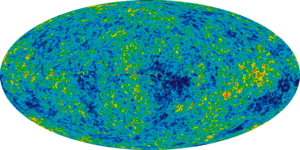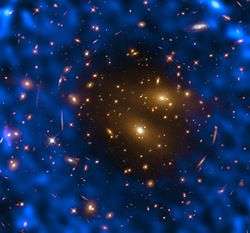Sunyaev–Zeldovich effect
The Sunyaev–Zeldovich effect (named after Rashid Sunyaev and Yakov B. Zeldovich and often abbreviated as the SZ effect) is the distortion of the cosmic microwave background radiation (CMB) through inverse Compton scattering by high-energy electrons in galaxy clusters, in which the low-energy CMB photons receive an average energy boost during collision with the high-energy cluster electrons. Observed distortions of the cosmic microwave background spectrum are used to detect the disturbance of density in the universe. Using the Sunyaev–Zeldovich effect, dense clusters of galaxies have been observed.
| Part of a series on | ||||
| Physical cosmology | ||||
|---|---|---|---|---|
 | ||||
|
Early universe
|
||||
|
Expansion · Future |
||||
|
Components · Structure
|
||||
| ||||
Overview
The Sunyaev–Zeldovich effect can be divided into:
- Thermal effects, where the CMB photons interact with electrons that have high energies due to their temperature
- Kinematic effects, a second-order effect where the CMB photons interact with electrons that have high energies due to their bulk motion (also called the Ostriker–Vishniac effect, after Jeremiah P. Ostriker and Ethan Vishniac.[1])
- polarization
Rashid Sunyaev and Yakov Zeldovich predicted the effect, and conducted research in 1969, 1972, and 1980. The Sunyaev–Zeldovich effect is of major astrophysical and cosmological interest. It can help determine the value of the Hubble constant. To distinguish the SZ effect due to galaxy clusters from ordinary density perturbations, both the spectral dependence and the spatial dependence of fluctuations in the cosmic microwave background are used. Analysis of CMB data at higher angular resolution (high -values) requires taking into account the Sunyaev–Zeldovich effect.
Current research is focused on modelling how the effect is generated by the intracluster plasma in galaxy clusters, and on using the effect to estimate the Hubble constant and to separate different components in the angular average statistics of fluctuations in the background. Hydrodynamic structure formation simulations are being studied to gain data on thermal and kinetic effects in the theory.[2] Observations are difficult due to the small amplitude of the effect and to confusion with experimental error and other sources of CMB temperature fluctuations. However, since the Sunyaev–Zeldovich effect is a scattering effect, its magnitude is independent of redshift. This is very important: it means that clusters at high redshift can be detected just as easily as those at low redshift. Another factor which facilitates high-redshift cluster detection is the angular scale versus redshift relation: it changes little between redshifts of 0.3 and 2, meaning that clusters between these redshifts have similar sizes on the sky. The use of surveys of clusters detected by their Sunyaev–Zeldovich effect for the determination of cosmological parameters has been demonstrated by Barbosa et al. (1996). This might help in understanding the dynamics of dark energy in surveys (South Pole Telescope, Atacama Cosmology Telescope, Planck).
Observations

In 1984, researchers from the Cambridge Radio Astronomy Group and the Owens Valley Radio Observatory first detected the Sunyaev–Zeldovich effect from clusters of galaxies [4]. Ten years later, the Ryle Telescope was used to image a cluster of galaxies in the Sunyaev–Zeldovich effect for the first time.
Instruments built specifically to study the effect include the Sunyaev–Zeldovich camera on the Atacama Pathfinder Experiment, and the Sunyaev–Zeldovich Array, which both saw first light in 2005. In 2012, the Atacama Cosmology Telescope (ACT) performed the first statistical detection of the kinematic SZ effect.[5] In 2012 the kinematic SZ effect was detected in an individual object for the first time in MACS J0717.5+3745.[6]
References
- Ostriker, Jeremiah P. & Vishniac, Ethan T. (1986). "Generation of Microwave Background Fluctuations from Nonlinear Perturbations at the Era of Galaxy Formation". Astrophysical Journal Letters. 306: L51. Bibcode:1986ApJ...306L..51O. doi:10.1086/184704.
- Cunnama D., Faltenbacher F.; Passmoor S., Cress C.; Cress, C.; Passmoor, S. (2009). "The velocity-shape alignment of clusters and the kinetic Sunyaev–Zeldovich effect". MNRAS Letters. 397 (1): L41–L45. arXiv:0904.4765. Bibcode:2009MNRAS.397L..41C. doi:10.1111/j.1745-3933.2009.00680.x. S2CID 9809159.
- "ALMA's Hole in the Universe". www.eso.org. Retrieved 20 February 2017.
- Birkinshaw, M.; Gull, S.F.; Hardebeck, H. (1984). "The Sunyaev-Zeldovich effect towards three clusters of galaxies". Nature. 309 (5963): 34–35. Bibcode:1984Natur.309...34B. doi:10.1038/309034a0. S2CID 4276748.
- Hand, Nick; Addison, Graeme E.; Aubourg, Eric; Battaglia, Nick; Battistelli, Elia S.; Bizyaev, Dmitry; Bond, J. Richard; Brewington, Howard; Brinkmann, Jon; Brown, Benjamin R.; Das, Sudeep; Dawson, Kyle S.; Devlin, Mark J.; Dunkley, Joanna; Dunner, Rolando; Eisenstein, Daniel J.; Fowler, Joseph W.; Gralla, Megan B.; Hajian, Amir; Halpern, Mark; Hilton, Matt; Hincks, Adam D.; Hlozek, Renée; Hughes, John P.; Infante, Leopoldo; Irwin, Kent D.; Kosowsky, Arthur; Lin, Yen-Ting; Malanushenko, Elena; et al. (2012). "Detection of Galaxy Cluster Motions with the Kinematic Sunyaev–Zeldovich Effect". Physical Review Letters. 109 (4): 041101. arXiv:1203.4219. Bibcode:2012PhRvL.109d1101H. doi:10.1103/PhysRevLett.109.041101. PMID 23006072. S2CID 11392448.
- Mroczkowski, Tony; Dicker, Simon; Sayers, Jack; Reese, Erik D.; Mason, Brian; Czakon, Nicole; Romero, Charles; Young, Alexander; Devlin, Mark; Golwala, Sunil; Korngut, Phillip; Sarazin, Craig; Bock, James; Koch, Patrick M.; Lin, Kai-Yang; Molnar, Sandor M.; Pierpaoli, Elena; Umetsu, Keiichi; Zemcov, Michael (2012). "A Multi-wavelength Study of the Sunyaev–Zel'dovich Effect in the Triple-merger Cluster MACS J0717.5+3745 with MUSTANG and Bolocam". Astrophysical Journal. 761 (1): 47. arXiv:1205.0052. Bibcode:2012ApJ...761...47M. doi:10.1088/0004-637X/761/1/47. S2CID 50951413.
Further reading
- Rephaeli, Y. (1995). "Comptonization Of The Cosmic Microwave Background: The Sunyaev–Zeldovich Effect". Annual Review of Astronomy and Astrophysics. 33 (1): 541–580. Bibcode:1995ARA&A..33..541R. doi:10.1146/annurev.aa.33.090195.002545.
- Barbosa, D.; Bartlett, J. G.; Blanchard, A.; Oukbir, J. (1996). "The Sunyaev–Zel'dovich effect and the value of Ω0". Astronomy and Astrophysics. 314: 13–17. arXiv:astro-ph/9511084. Bibcode:1996A&A...314...13B.
- Birkinshaw, M.; Gull, S. F.; Hardebeck, H. (1984). "The Sunyaev–Zel'dovich effect towards three clusters of galaxies". Nature. 309 (5963): 34–35. Bibcode:1984Natur.309...34B. doi:10.1038/309034a0. S2CID 4276748.
- Birkinshaw, Mark (1999). "The Sunyaev Zel'dovich Effect". Physics Reports. 310 (2–3): 97–195. arXiv:astro-ph/9808050. Bibcode:1999PhR...310...97B. doi:10.1016/S0370-1573(98)00080-5. hdl:1983/5d24f14a-26e0-44d3-8496-5843b108fec5. S2CID 119330362.
- Cen, Renyue; Jeremiah P. Ostriker (1994). "A hydrodynamic approach to cosmology: the mixed dark matter cosmological scenario". The Astrophysical Journal. 431 (1994): 451. arXiv:astro-ph/9404011. Bibcode:1994ApJ...431..451C. CiteSeerX 10.1.1.254.3635. doi:10.1086/174499. S2CID 1284598. Archived from the original on 22 February 2004.
- Hu, Jian; Yu-Qing Lou (2004). "Magnetic Sunyaev–Zel'dovich effect in galaxy clusters". Astrophysical Journal Letters. 606 (1): L1–L4. arXiv:astro-ph/0402669. Bibcode:2004ApJ...606L...1H. doi:10.1086/420896. S2CID 10520376.
- Ma, Chung-Pei; J. N. Fry (27 May 2002). "Nonlinear Kinetic Sunyaev–Zel'dovich Effect". Physical Review Letters. 88 (21): 211301. arXiv:astro-ph/0106342. Bibcode:2002PhRvL..88u1301M. doi:10.1103/PhysRevLett.88.211301. PMID 12059470. S2CID 5655238.
- Myers, A. D.; Shanks, T.; et al. (2004). "Evidence for an Extended SZ Effect in WMAP Data". Monthly Notices of the Royal Astronomical Society. 347 (4): L67–L72. arXiv:astro-ph/0306180. Bibcode:2004MNRAS.347L..67M. doi:10.1111/j.1365-2966.2004.07449.x. S2CID 53119165.
- Springel, Volker; White, Martin; Hernquist, Lars (2001). "Hydrodynamic Simulations of the Sunyaev–Zel'dovich effect(s)". Astrophysical Journal. 549 (2): 681–687. arXiv:astro-ph/0008133. Bibcode:2001ApJ...549..681S. doi:10.1086/319473. S2CID 6728519.
- Sunyaev, R. A.; Ya. B. Zel'dovich (1970). "Small-Scale Fluctuations of Relic Radiation". Astrophysics and Space Science. 7 (1): 3–19. Bibcode:1970Ap&SS...7....3S. doi:10.1007/BF00653471 (inactive 10 July 2020).
- Sunyaev, R. A.; Ia. B. Zel'dovich (1980). "Microwave background radiation as a probe of the contemporary structure and history of the universe". Annual Review of Astronomy and Astrophysics. 18 (1): 537–560. Bibcode:1980ARA&A..18..537S. doi:10.1146/annurev.aa.18.090180.002541.
- Diego, J. M.; Martinez, E.; Sanz, J. L.; Benitez, N.; Silk, J. (2002). "The Sunyaev–Zel'dovich effect as a cosmological discriminator". Monthly Notices of the Royal Astronomical Society. 331 (3): 556–568. arXiv:astro-ph/0103512. Bibcode:2002MNRAS.331..556D. doi:10.1046/j.1365-8711.2002.05039.x. S2CID 10486016.
- Royal Astronomical Society, Corrupted echoes from the Big Bang? RAS Press Notice PN 04/01
External links
- Corrupted echoes from the Big Bang? innovations-report.com.
- Sunyaev–Zel'dovich effect on arxiv.org
